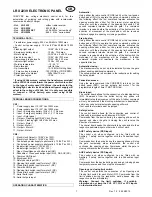
simultaneously), press the SEL button until the T.MOT.PED
Led flashes then press the SET key, at the same time the
T.MOT.PED LED turns on and remains steady and
programming is complete.
In this way, the PUL input enables connection of a (NO) button
just for the opening phase, and the PED input enables
connection of a (NO) button just for the closing phase. Repeat
the operation to restore the previous configuration.
EXTENDED MENU 3
The control unit is supplied by the manufacturer with only the
option of directly selecting the functions listed in the main
menu.
To enable programming of the control unit’s deceleration
power, proceed as follows: open Extended Menu 2 (as
instruction in the respective section), then press and hold the
SET button for 5 seconds at the end of which the T.PAUSA and
RIT. ANTE LEDs flash in alternation and then simultaneously;
you have 30 seconds to select the required deceleration value
using the SEL and SET buttons; after another 30 seconds, the
control unit returns to the main menu.
---------------------- EXTENDED MENU 3 -----------------
Level LEDs on
1 TIPO MOTORE
2 TIPO MOTORE - AUTO PGM
3 TIPO MOTORE - AUTO PGM - CODE
4 TIPO MOTORE - AUTO PGM - CODE - CODE PED.
5 TIPO MOTORE - AUTO PGM - CODE - CODE PED. - T. MOT.
6 TIPO MOT. - AUTO PGM - CODE - CODE PED. - T. MOT. - T.MOT.PED.
Programming deceleration
The control unit allows you to program the power for the
deceleration phase.
You can choose between 6 different levels of power: each
combination of lighted LEDs is associated with a level, as
indicated in the table above; in practice, the number of LEDs
switched on (starting with the TIPO MOTORE Led) indicates
the level of power. Use the SEL button to scroll through the
levels of power; for each level of power selected, the highest
LED in the respective set flashes (for instance, if you select
level 4, the TIPO MOTORE, AUTO PGM and CODE LEDs are
steady while the CODE PED Led flashes); press SET to
confirm.
The default setting is Level 3.
RESET:
To restore the default configuration, press the SEL and
SET keys simultaneously; all
RED
LEDs will light up and
then switch off.
DIAGNOSTICS:
Photocell test:
The control unit can be fitted with safety devices in accordance
with step 5.1.1.6 of the EN 12453 standard. Each work cycle
includes a test to check the working order of the connected
photocell. If the photocell is not connected and/or not working,
the control unit disables operation and all the LEDs flash at the
same time to indicate the test has failed. The photocell has to
be fixed before the control unit can be put to normal use again.
This guarantees monitoring of faults in according with Category
2 of EN 954-1.
Command input test:
The control unit is fitted with a LED for each low voltage
command input, allowing you to monitor status quickly.
Operating principle: LED on = input closed, LED off = input
open.
F
OR
THE
USER
–
IMPORTANT
- The device should not be used by children or by
individuals with reduced physical or psychological abilities
unless supervision is provided or instruction given on how
to operate it.
- Do not let children play with the device; keep radio
controls out of their reach.
- CAUTION: Keep this instruction manual in a safe place
and adhere to the important safety instructions contained
within it. Non-adherence to these instructions may lead to
property damage and serious accidents.
- Examine the system frequently to check for any signs of
damage. Do not use the device if it needs to be repaired.
Warning
All operations which require the casing to be opened (such as
wire connection, programming, etc.) must be carried out during
installation, by skilled staff only.
For any other procedure which requires the casing to be
opened again (programming, repairs or site modifications),
please contact the technical assistance service.
5 Rev. 1.0 08/10/2010
Содержание LRS 2239
Страница 7: ...7 Rev 1 0 08 10 2010 ...

























